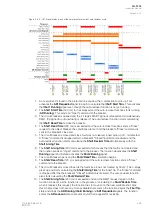
4. The SSho
hot1 Dead T
t1 Dead Time
ime (200 ms) is exceeded and the function sends a "Close" request to the
object breaker (AR Br
AR Break
eaker
er): the conditions are met and the breaker's "Close" command is
sent to the breaker's close coil.
5. The circuit breaker is closed towards the fault as it was not cleared by Shot 1 given the non-
energized time. The I0dir> stage picks up and starts calculating the operating time for a trip.
A "Close" command is dropped after the breaker's "Closed" indication is received and the
auto-recloser function starts calculating SSho
hot1
t1 R
Reclaim T
eclaim Time
ime.
6. The I0Dir> stage trips a second time and gives the REQ2 request to the function. However,
as the function is in the process of calculating the Shot1 Reclaim Time when it receives this
request, the function moves on to the next available shot (Shot 2) for the request. The SSho
hot2
t2
Running
Running signal is set to active and the SSho
hot1 Running
t1 Running is terminated.
7. The circuit breaker is opened and the I0Dir> TRIP signal is released and simultaneously
REQ2 trip signal for auto-recloser is released. The recloser starts calculating the SSho
hot2 Dead
t2 Dead
TTime
ime to close the breaker.
8. The SSho
hot2 Dead T
t2 Dead Time
ime (60 s) is exceeded and the function sends a "Close" request to the
object breaker: the conditions are met and the breaker's "Close" command is sent to the
breaker's close coil.
9. The circuit breaker is closed towards the fault since it was not cleared by Shot 2. The I0dir>
stage picks up and starts calculating the operating time for a trip. A "Close" command is
dropped after the breaker's "Closed" indication is received and the auto-
recloser function starts calculating SSho
hot2
t2 R
Reclaim T
eclaim Time
ime.
10. The I0Dir> stage trips a third time and gives the REQ2 request to the function. However, as
the function is in the process of calculating the SSho
hot2 R
t2 Reclaim T
eclaim Time
ime when it receives this
request, the function tries to move on to the next available shot. Alas, this scheme does not
have any more available shots and so the function begins the FFinal T
inal Trip
rip state and drops the
AR Running
AR Running, SSho
hot2 Running
t2 Running and AR2 R
AR2 Request
equested
ed signals. The function enters the AR L
AR Lock-
ock-
out
out state to prevent any further requests for reclosing.
11. The circuit breaker is opened and the I0Dir> TRIP signal is released, and simultaneously the
REQ2 trip signal for the auto-recloser is released. The function is now in a steady lock-out
state and waits for the user to manually reset and re-initialize the function by closing the
breaker.
Auto-recloser sequence from Trip with two shots (high-speed fails, time-delayed
succeeds).
This auto-recloser scheme has the same starters and shots as the previous example. The setting and
signals are also the same. However, in this example the fault persists the high-speed shot but is cleared
by the time-delayed shot.
Figure. 5.4.4 - 182. Settings for I0dir> with two shots.
This type of sequence (i.e. two shots required to clear the fault) represents 10...15 % of all faults that
occur in MV overhead line networks.
A
AQ
Q-F205
-F205
Instruction manual
Version: 2.04
© Arcteq Relays Ltd
IM00013
265
Summary of Contents for AQ F205
Page 1: ...AQ F205 Feeder protection IED Instruction manual ...
Page 2: ......










































